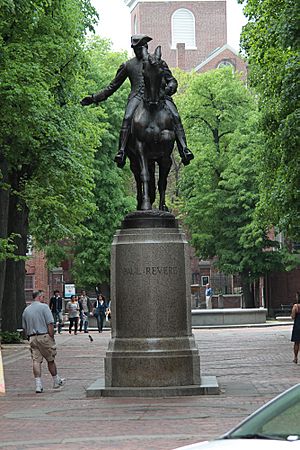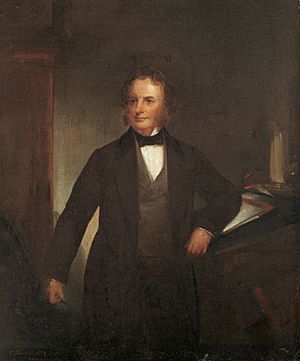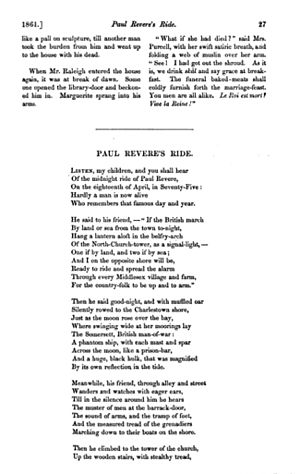Paul Revere's Ride facts for kids
"Paul Revere's Ride" is a famous poem written in 1860 by American poet Henry Wadsworth Longfellow. It tells the story of Paul Revere and his important actions on April 18, 1775. This was the night before the American Revolutionary War officially began. The poem was first published in 1861 in a magazine called The Atlantic Monthly. Later, it was given a new title, "The Landlord's Tale", and included in Longfellow's book Tales of a Wayside Inn in 1863. While the poem is very popular, it does have some parts that are not historically accurate.
Contents
The Story of the Poem
The poem is told by the landlord of the Wayside Inn. It shares a story about Paul Revere that is partly made up. In the poem, Revere asks a friend to set up signal lanterns in the Old North Church in North End, Boston. These lights would tell Revere if the British soldiers were coming by land or by sea.
Revere waits for the signal across the river in Charlestown. He is ready to ride and warn everyone in Middlesex County, Massachusetts. His friend climbs the church steeple and lights two lanterns. This tells Revere that the British are coming by sea. Revere then rides his horse through towns like Medford, Lexington, and Concord. He warns the American patriots that the British are on their way.
How the Poem Was Made
Longfellow got the idea for "Paul Revere's Ride" after visiting the Old North Church. He even climbed its tall tower on April 5, 1860. He started writing the poem the very next day. It first appeared in the January 1861 issue of The Atlantic Monthly.
The poem was later republished in Longfellow's book Tales of a Wayside Inn in 1863. It was the first of 22 stories in this collection. The collection was similar to The Canterbury Tales by Geoffrey Chaucer. Longfellow's family also had a special connection to Paul Revere. His grandfather, Peleg Wadsworth, was Revere's commander during a military event called the Penobscot Expedition.
What Critics Say About the Poem
People who study poems often talk about the historical mistakes in "Paul Revere's Ride." For example, the poem says the lanterns in the Old North Church were a signal for Revere. But in real life, Revere was the one who ordered the signal to be set up. He did not receive it himself. The poem also says Revere rowed himself across the Charles River. Actually, other people rowed him. He also did not reach Concord that night. The poem also makes the events of the night seem longer than they really were.
The biggest criticism is that Longfellow gives all the credit to Revere. In reality, three riders, not just Revere, helped warn the colonists. William Dawes and Samuel Prescott also rode that night. Revere and Dawes rode from Boston to Lexington. They wanted to warn John Hancock and Samuel Adams that British soldiers were coming to arrest them. The British also planned to take weapons stored in Concord.
Revere, Dawes, and Prescott rode toward Concord, where the weapons were hidden. British troops stopped them in Lincoln. Prescott and Dawes managed to escape. But Revere was captured, questioned, and then taken back to Lexington by British officers. Of the three riders, only Prescott made it to Concord in time to warn the local militia.
How the Poem Changed History

Longfellow's poem is given credit for making Paul Revere a national hero. Before the poem, Revere was a less known Massachusetts silversmith. When Revere died in 1818, his obituary did not even mention his midnight ride. It focused more on his business and friends.
The fame that Longfellow brought to Revere grew after the Civil War. This was during a time called the Colonial Revival Movement in the 1870s. In 1875, the Old North Church started an annual "lantern ceremony." This event recreates the signal from the poem. Three years later, the church added a plaque. It marked the church as the place of "the signal lanterns of Paul Revere."
Revere's new importance even led to false stories. One rumor said he made false teeth for George Washington. Revere's legendary status continued for many years. Because of Longfellow's poem, real silverware made by Revere became very valuable. A rich businessman named J. P. Morgan even offered $100,000 for a punch bowl Revere had made.
In 1883, Boston held a contest for a statue of Revere on a horse. Cyrus Edwin Dallin won the contest. His statue was finally put up in 1940. It stands in "Paul Revere Plaza," right across from the Old North Church.
In 1896, Helen F. Moore wrote a funny poem that copied Longfellow's style. She was upset that William Dawes had been forgotten. Her poem said:
- 'Tis all very well for the children to hear
- Of the midnight ride of Paul Revere;
- But why should my name be quite forgot,
- Who rode as boldly and well, God wot?
- Why should I ask? The reason is clear—
- My name was Dawes and his Revere.
In 2007, the United States Postal Service (USPS) released a special stamp. It had pictures that referred to Longfellow's poem. The stamp showed a painting by artist Kazuhiko Sano.
|




